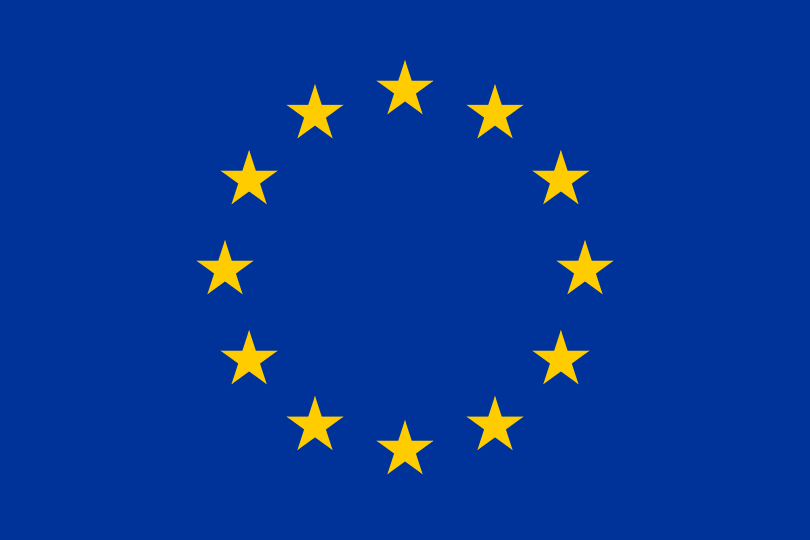CEF-Digital funded 5G corridor projects
Call 1 to 3
This map lists our projects showing how deploying 5G cross-border corridors along transport paths throughout Europe is expected to contribute to the green and digital transformation of the EU economy and society.
In particular, 5G-enabled Connected and Automated Mobility (CAM) is seen as a major enabler for improved road safety, optimised road traffic, reduced CO₂ emissions, and industrial competitiveness of both the transport and mobility sectors.
Road and rail network based on the list of 5G corridors and cross-border backbone connections identified in Part V of the Annex of CEF Regulation (EU) 2021/1153.
INTERACTIVE MAP
Click on the project names to see more information.
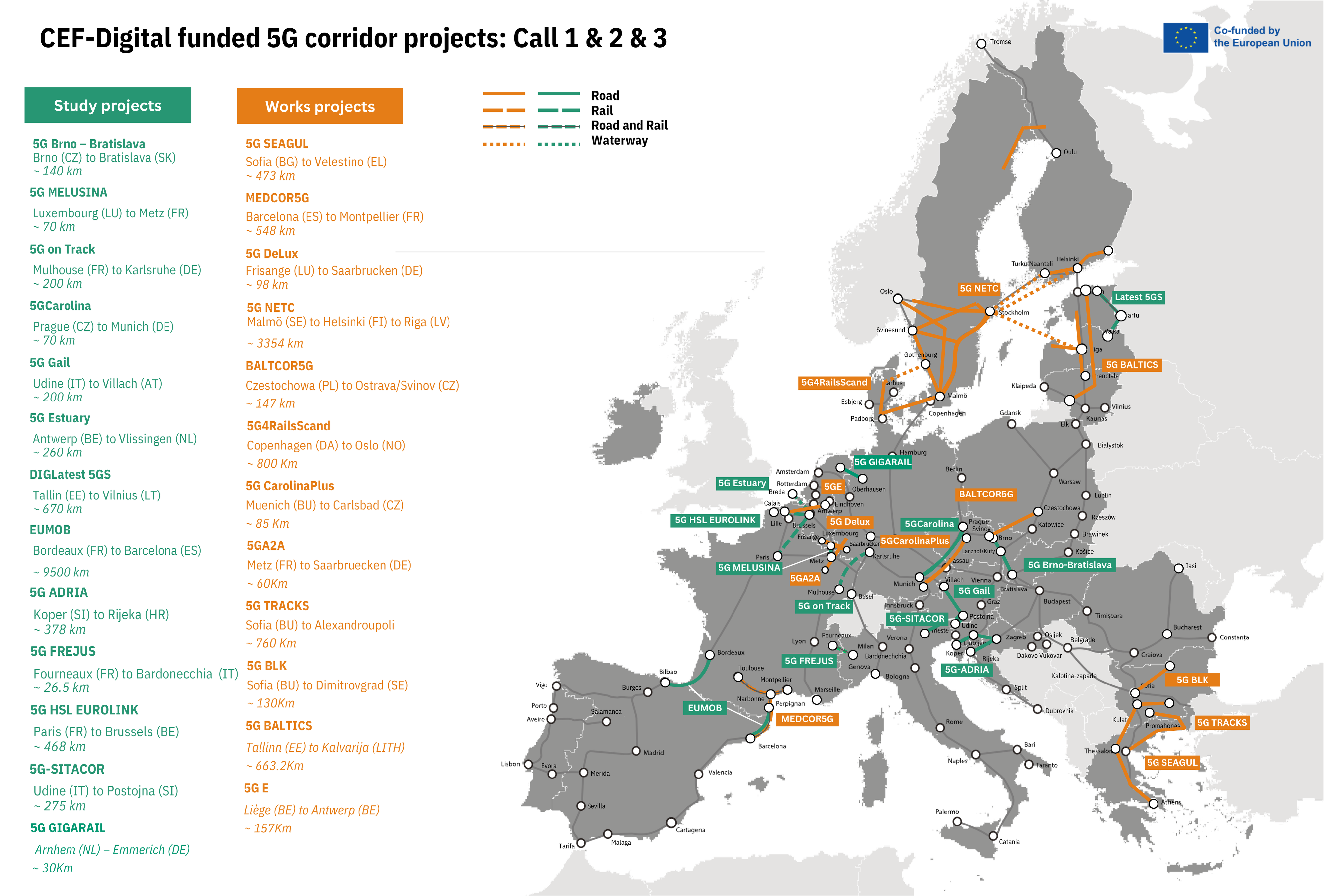
5G SEAGUL

- Corridor: Sofia (Bulgaria) - Kulata/Promahonas - Velestino (Greece)
- TEN-T corridor: Orient/East-Mediterranean
- Length: 473 km
- Spectrum bands: 700MHz and 3.5Ghz
- Total EU Grant: €5,748,000.00
- Project running: 36 months (January 2023 - December 2025)
This project, led by WINGS ICT Solutions, Cosmote and A1 Bulgaria EAD, will target the deployment and upgrade of 5G RAN for transportation uses with a focus on connectivity across the border between Bulgaria and Greece to support Connected and Automated Mobility (CAM) services. The project aims to achieve an optimum network interconnection and roaming/handover configuration while measuring the smooth handover experienced by connected vehicles and validating via real-life cross-border trials.
MEDCOR5G

- Corridor: Barcelona – Figueres (Spain)/ Perpignan - Montpellier – Toulouse (France)
- TEN-T corridor: Mediterranean
- Length: 548 km
- Spectrum bands: 700MHz and 3.5Ghz
- Total EU Grant: €5,204,747.96
- Project running: 36 months (January 2023 - December 2025)
Led by Tradia Telecom in collaboration with Cellnex France, this project aims to establish uninterrupted 5G coverage along the cross-border sections of the Mediterranean corridor, focusing on areas where market investment in passive/active infrastructure is lacking. The goal is to ensure continuous coverage, maintaining a high-quality service to support Connected Automated Mobility (CAM) services. The project involves the construction of new radio sites in regions with limited or no 5G coverage, benefiting various stakeholders, including Mobile Network Operators (MNOs), road/rail infrastructure operators, and Original Equipment Manufacturers (OEMs).
5G Delux
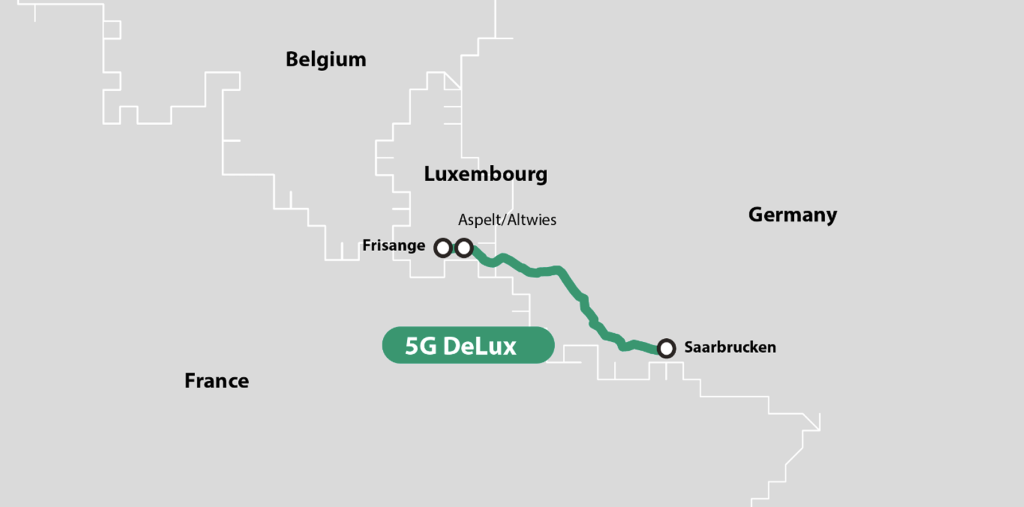
- Corridor: Frisange (Luxembourg) - Aspelt/Altwies - Saarbrucken (Germany)
- Length: 98 km
- Spectrum bands: 700 MHz, 900 MHz and 3.6 GHz
- Total EU Grant: €6,338,325.50
- Project running: 36 months (January 2023 – December 2025)
5G DeLux is a joint effort between Telekom Deutschland, Post Luxembourg and BMW Group that aims to enable high-performing network coverage and a seamless handover of connected devices when crossing the German-Luxembourgish border. This seamless handover solution should be a blueprint solution for intra-EU borders.
5G NETC

- Corridor: Sweden - Finland - Latvia
- TEN-T corridors: Scandinavian-Mediterranean & North Sea-Baltic
- Length: > 3354 km
- Spectrum bands: 3GPP TS 38.101-1 V16.12.1 (2022-06): n28 703 MHz – 748 MHz/758 MHz – 803 MHz (FDD); n78 - 3300 MHz – 3800 MHz (TDD)
- Total EU Grant: €15,535,000.00
- Project running: 36 months (May 2022 – April 2025)
5G NETC aims to improve cross-border network service continuity for established services and adopt 5G infrastructure in public environments to support new 5G services and applications. The project is a joint effort from Telia Sweden, Telia Finland and Latvia Mobilais Telefons. The goal is to enable applications and services for road CAM and Future Railway Mobile Communication Systems (FRMCS) use case solutions and their introduction.
5G Brno – Bratislava
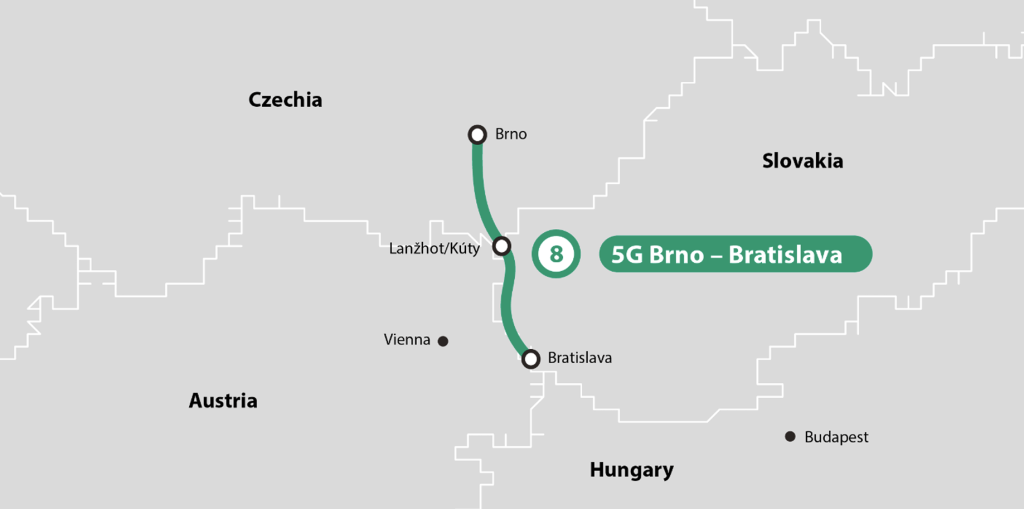
- Corridor: Brno (Czech Republic) - Lanžhot / Kúty – Bratislava (Slovak Republic)
- Length: 141 km
- Spectrum bands: 5G (700MHz, 3.4-3.8MHz, ITS 5.9GHz, 26GHz), FRMCS (900MHz, 1900MHz)
- Total EU Grant: €300,000
- Project ended: 17 months (January 2023 – May 2024)
5G Brno – Bratislava is a study carried out by the Czech Republic (Správa železnic) together with the Slovak Republic (Železnice Slovenskej republiky) to address the implementation of 5G and FRMCS communication systems between Brno and Bratislava. The study aims to prepare for connected and automated mobility services taking into account the existing communication environment and requirements for the transport path.
5G MELUSINA

- Corridor: France: Metz (France) - Luxembourg City (Luxembourg)
- TEN-T corridor: North Sea-Mediterranean (from Brussels to Strasbourg)
- Length: 67 km total, 50 of which in France and 17 in Luxembourg
- Spectrum bands: 700 MHz and 3,5 GHz
- Total EU Grant: €255,377
- Project ended: 6 months (January 2023 – June 2023)
This inception study, carried out by railway infrastructure managers SNCF Reseau and CFL in a consortium of six partners involving four public Mobile Network Operators (MNOs) from Luxembourg, prepared the deployment of 5G infrastructure for rail use cases. These cover digital railway operation and passenger connectivity enhancement by densifying telecommunications infrastructure and pushing for a complete 5G coverage. To achieve this with optimal resources, cooperation and synergy are key between railway and public mobile network operators.
5G on Track

5GCarolina
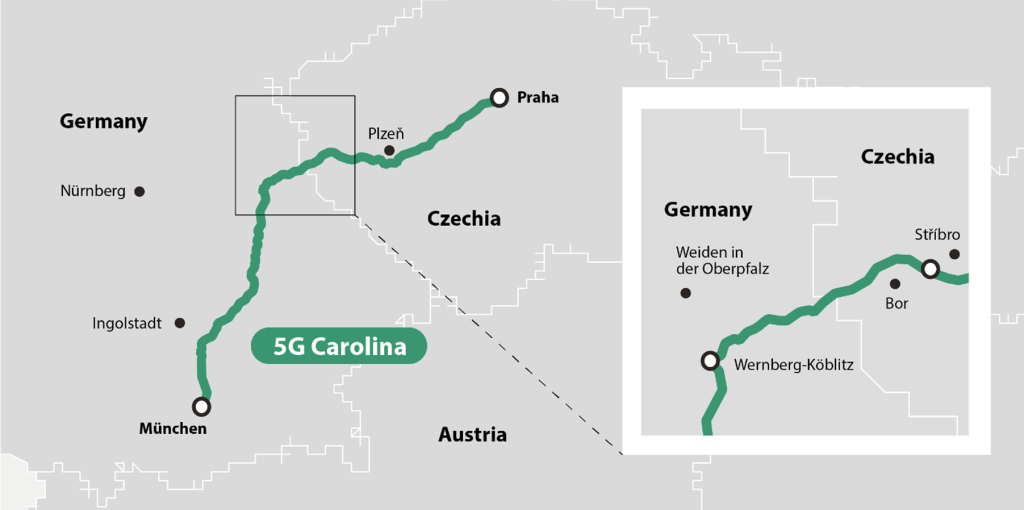
- Corridor: Nova Hospoda (Czech Republic) - Rozvadov/Waidhaus - Wernberg-Köblitz (Germany)
- TEN-T corridor: Rhine-Danube
- Length: 70 km
- Spectrum bands: Low - (700 MHz), Mid - (1800/2100 MHz) and C-Band (3,6 GHz) and mmWaves (26-28 GHz)
- Total EU Grant: €238,000
- Project ended: 6 months (January 2023 - June 2023 )
5G Carolina is a joint effort from T-Mobile CZ, together with CETIN and Vantage Towers AG as part of a consortium of 13 partners, that aims explicitly at preparing the 5G systems deployment needed along the 5G Corridor Munich-Prague to enable CCAM throughout the network across all Mobile Network Operators and Vehicle Manufacturers.
5G Gail
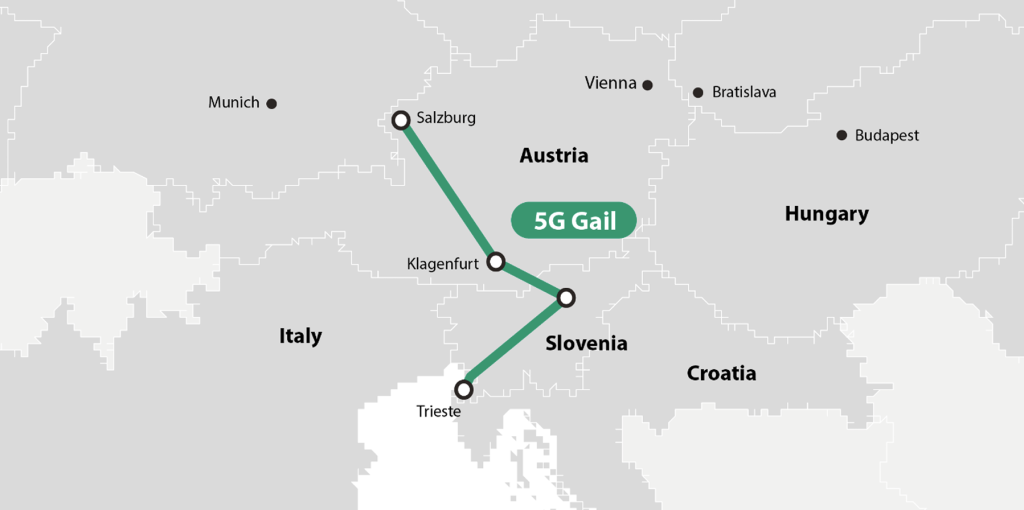
- Corridor: Italy: Udine – Tarvisio/Arnoldstein – Villach: Austria
- TEN-T corridor: Baltic-Adriatic Corridor
- Length: 130 km
- Spectrum bands: 700MHz frequency band licensed for 5G
- Total EU Grant: €139,750
- Project ended: 7 months (January 2023 – July 2023)
5G GAIL is a modular study carried out by Cellnex Italia together with OnTower Austria, Autostrade per l’Italia, and the regional Public Authority on the Italian side (Regione Friuli-Venezia Giulia - RFVG) to assess the effort needed to deploy the transport corridor between Italy and Austria across the Tarvis border, with a neutral and agnostic, passive and active, infrastructure dedicated to the development of digital services, and in particular, the deployment of safe, secure, and sustainable high-performance infrastructure, including Gigabit and 5G networks.
5G Estuary

- Corridor: Netherlands - Belgium, from the North Sea, along the west section of the river Scheldt and associated inland waterways.
- Length: 259.5 km
- Spectrum bands: 700MHz and 3.6 GHz (5GE is a study, there was no deployment) Standards: 5G
- Total EU Grant: €300,000
- Project ended: 9 months (October 2022 - June 2023)
5G Estuary is a study conducted by KPN Netherlands and Orange Belgium to define a cross-border 5G digital corridor for mobility applications and low-altitude aviation that will make essential nodes in the global supply chain more efficient, safer and sustainable.
Latest 5GS
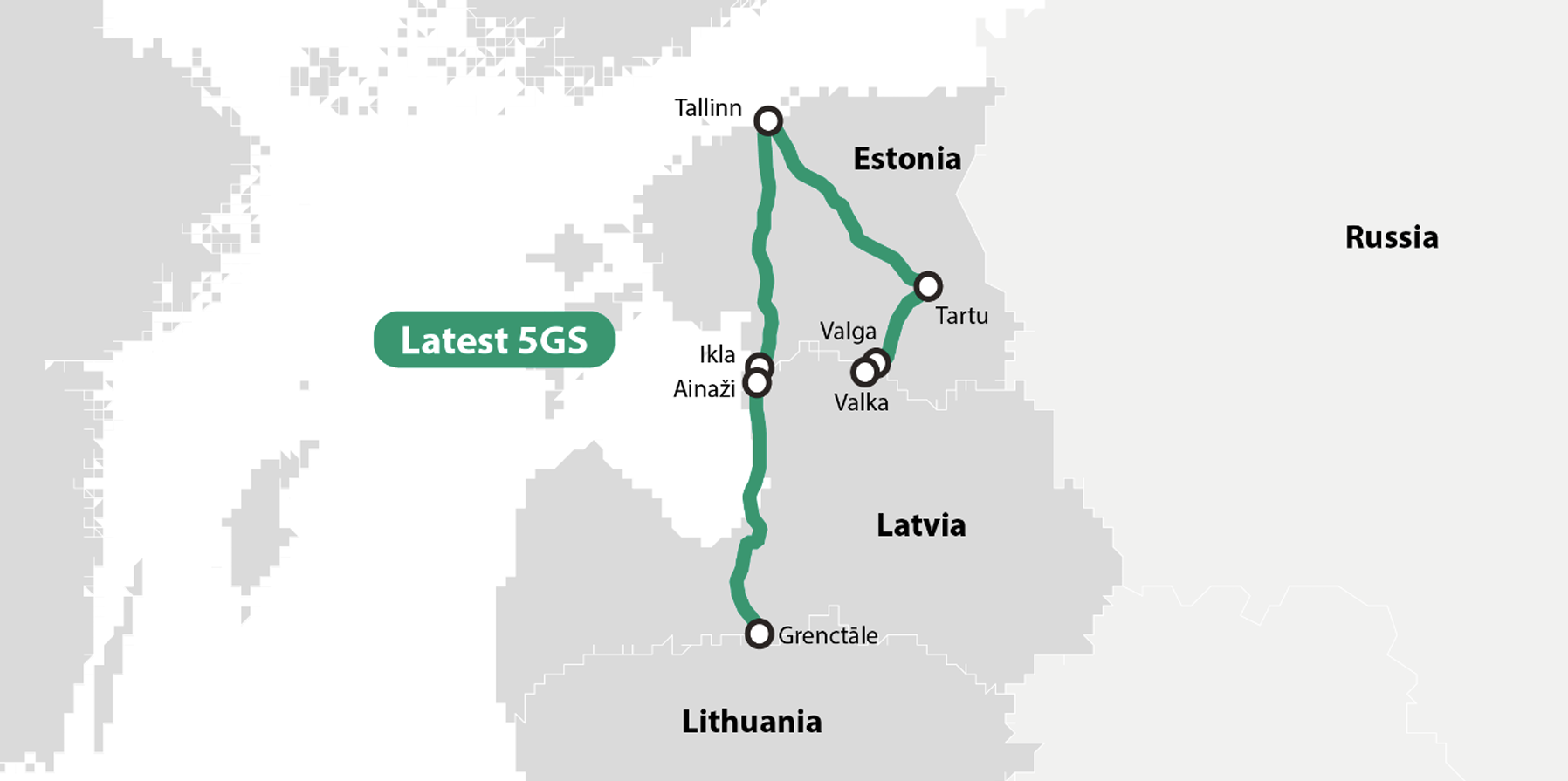
- Corridor: Tallinn - Ikla; Tallinn – Tartu - Valga (Estonia) / Ainaži - Grenctāle; Valga - Valka (Latvia)
- TEN-T corridor: North Sea-Baltic
- Length: 695 km
- Spectrum bands: 700 MHz, 3.5 GHz
- Total EU Grant: €249,302
- Project ended: 6 months (January 2023 – June 2023)
The Latest 5GS study, carried out by Tallinn University of Technology (Tallinna Tehnikaülikool - TalTech) together with the Estonian Broadband Association (Eesti Lairiba Arenduse Sihtasutus - ELA SA), Valsts Akciju Sabiedriba Elektroniskie Sakari (VASES), Telia Estonia, and Elisa Estonia, focuses on providing technical solutions and financial model(s) to deploy 5G infrastructure along the Via Baltica and Rail Baltica corridors capable of providing cross-border 5G services in the Baltic States.
EUMOB

- Corridor: FR-ES sections of the cross-border Atlantic and Mediterranean corridors
- Length: 9440 km, 5627 km of which in Spain and 3813 km in France
- Spectrum bands: wide spectrum (check Fiche project for more)
- Total EU Grant: €146,800
- Project ended: 6 months (January 2023 - June 2023)
EUMOB is a cross-border feasibility study between Spain and France. The project is a joint effort between Abertis Autopistas Espana, Cellnex France, SANEF, and Tradia Telecom that focuses on the digitalisation of European road infrastructure to support the harmonised deployment of C-ITS services and the subsequent development of service-driven business ecosystems in transport and mobility.
BALTCOR5G
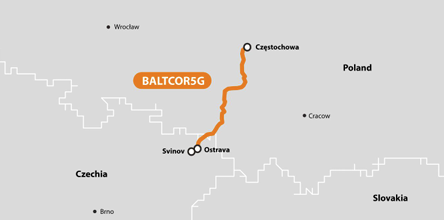
- Corridor: Częstochowa (Poland) -
Ostrava/Svinov (Czech Republic) - TEN-T corridor: Mediterranean
- Length: 147 km
- Spectrum bands: 5.9 GHz
- Total EU Grant: €2,058,524
- Project running: 36 months (January 2024 - December 2026)
This project aims to build a 5G and C-v2x infrastructure connecting cross-border road corridor sections along the Baltic-Adriatic 5G Corridor between Poland and the Czech Republic to enable high-quality seamless network coverage and handover. Towerlink Poland will work with CETIN AS to develop new business models in areas of market failure for the provision of digital services.
5G HSL EUROLINK

- Corridor: Paris (France) - Brussels (Belgium)
- TEN-T corridor: North Sea to the Mediterranean
- Length: 468 km
- Spectrum bands: 700 MHz and 3,5 GHz
- Total EU Grant: €433,145
- Project running
The 5GHSL Eurolink project aims to carry out an initial study to prepare the deployment of 5G infrastructure along a cross-border railway section between Paris (France) and Brussels (Belgium) for the benefit of connecting rail passengers and digitalising rail transport.
5G-SITACOR
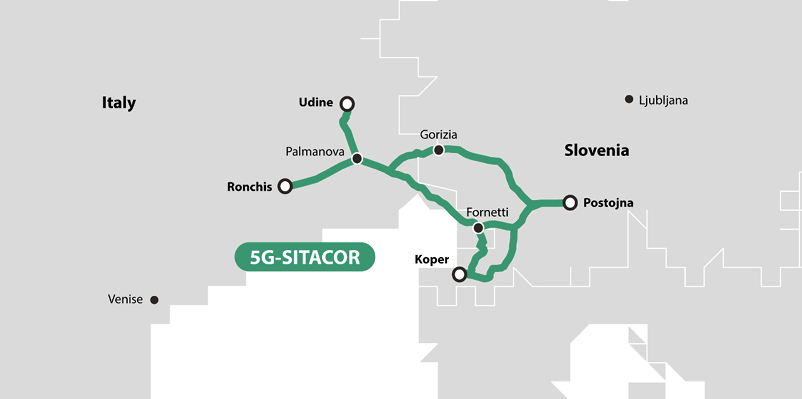
- Corridor: Udine (IT) Postojona (SI)
- TEN-T corridor: Adriatic - Baltic & Mediterranean
- Length: 275 km
- Spectrum bands: large from N7 700 MHz to 5900 GHz for V2V
- Total EU Grant: €342,742
- Project running: 6 months (January 2024 - July 2024)
The study is a fundamental step in the 5G deployment of the TEN T Mediterranean and Baltic Adriatic corridors, especially cross-border sections, between Friuli Venezia Giulia
Region (Italy) and the Republic of Slovenia, with a neutral, agnostic passive and active infrastructure dedicated to the development of digital services, in particular, concerning the deployment of safe, secure and sustainable high-performance infrastructure, including Gigabit and 5G networks.
5G Fréjus
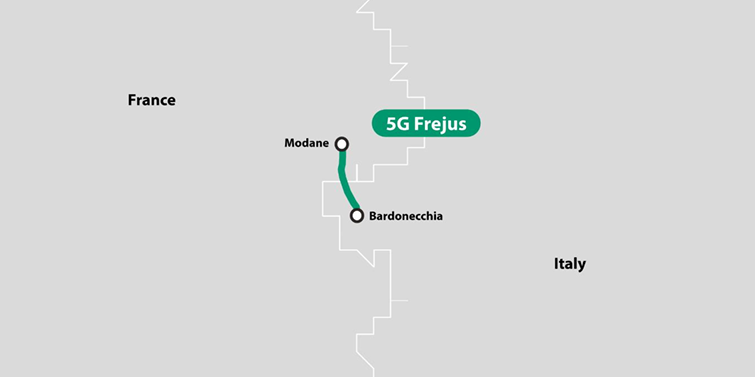
- Corridor: Fourneaux (FR) to Bardonechchia (IT)
- TEN-T corridor: Rhine-Alpine
- Length: 26.5 km
- Spectrum bands: 4G bands (800MHz - 2100MHz), 5G bands (700MHz, 3700MHz)
- Total EU Grant: €400, 723
- Project running: 36 months (January 2024 - December 2026)
5G Fréjus will present an inception study for the deployment of 5G and assess the efforts required to fully develop the transport corridor between Italy and France via the Fréjus rail and road tunnels with a neutral and agnostic passive and active infrastructure for the development of digital services.
5G BLK
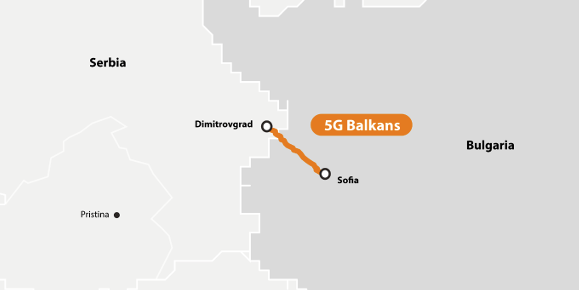
- Corridor: Koper (SI) to Rijeka (HR)
- TEN-T corridor: Mediterranean
- Length: 378 km
- Spectrum bands: N28 and N78
- Total EU Grant: €735, 225
- Project running: 6 months (January 2024 - June 2024)
The 5G-ADRIA project will focus on identifying what 5G infrastructure is needed to support future transport-related services deployed along the TEN-T transport corridors in Slovenia and Croatia. In addition, the proposed corridor connects TEN-T core ports in the northern Adriatic, in particular Koper and Rijeka.
5G TRACKS
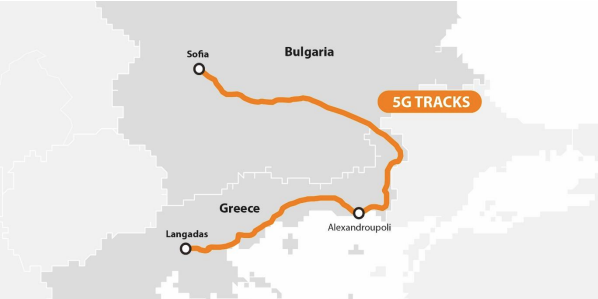
- Corridor: Cross-border sections between Greece and Bulgaria
- TEN-T corridor: Orient/East-Med and Baltic Sea - Black Sea - Aegean
- Length: 761 km
- Spectrum bands: 700 MHz, and the 3.6 GHz in “hotspot” areas with increased traffic demand
- Total EU Grant: 9,105,669.14 (50%)
- Project duration: 36 months December 2024 - November 2027)
As a direct result of this new connectivity, the project will install 5G-enabled meteorological stations on the Sofia- Haskovo-Kapitan Andreevo corridor sections. Additionally, the project will contribute to the
clustering of 5G initiatives with the development of concepts and facilities for the interconnection of the 5G corridor sections between Bulgaria and Greece.
5G BALTICS
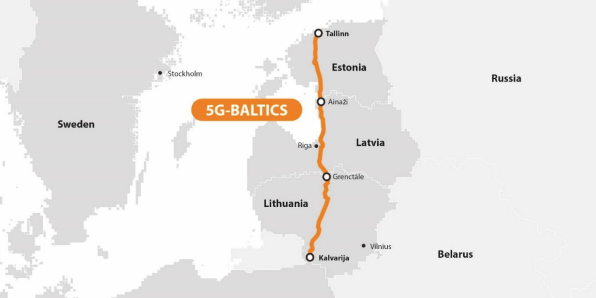
- Corridor: Via Baltica road cross-border sections: Ikla/ Ainaži - Grenctāle/ Saločiai - Kalvarija
- TEN-T corridor: Via Baltica
- Length: 663.2 km
- Spectrum bands: 700 MHz radio frequency band, 3400-3800 MHz radio frequency band spectrum
- Total EU Grant: 8,287,283.50 € (50%)
- Project running: 36 months (January 2025 – December 2027)
This project aims to advance Europe’s digital connectivity by deploying robust 5G infrastructure along the Via Baltica corridor, a vital transport route linking Estonia, Latvia, and Lithuania. Aligned with the EU’s vision for smarter and more sustainable mobility, it builds on previous studies to meet the growing demand for faster, more reliable digital communication services.
5G4RailsScand
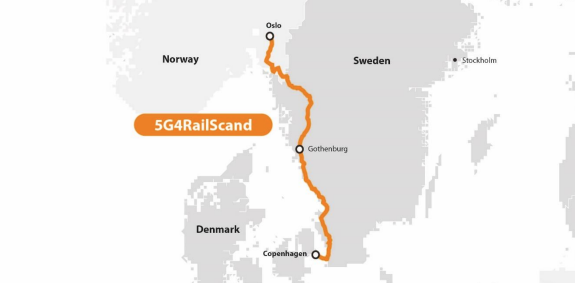
- TEN-T Corridor: Scandinavian-Mediterranean
Corridor: Scandinavian-Mediterranean corridor, Copenhagen-Gothenburg-Oslo (border crossings: Norway-Sweden, Sweden-Denmark) - Length: 800 km
- Spectrum bands: C-band
- Total EU grant: €18,018,000.00 (50%)
Project duration: 36 months (January 2025 - December 2027)
The 5GCarolinaPlus project leverages the historic trade and business ties between Germany and Czechia to foster renewed cross-border collaboration while addressing the transformation needs of the Carlsbad and Tachov regions. By deploying advanced 5G infrastructure, the project will deliver uninterrupted CCAM services across 85 km of cross-border corridors and 9 border crossings.
5GCarolinaPlus
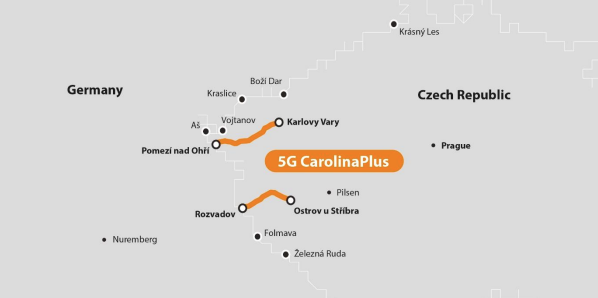
- Corridor: Munich (DE) - Prague (CZ) + Nuremberg (DE) - Carlsbad (CZ)
- TEN-T corridor: Highway Corridors & Border Crossings Between Germany and Czechia
- Length: 35 + 50 km
- Spectrum bands: C-band
- Total EU grant: €7,000,000.00 (50%)
- Project running: 36 months (January 2025 - December 2027)
The 5GCarolinaPlus project leverages the historic trade and business ties between Germany and Czechia to foster renewed cross-border collaboration while addressing the transformation needs of the Carlsbad and Tachov regions. By deploying advanced 5G infrastructure, the project will deliver uninterrupted CCAM services across 85 km of cross-border corridors and 9 border crossings.
5GA2A
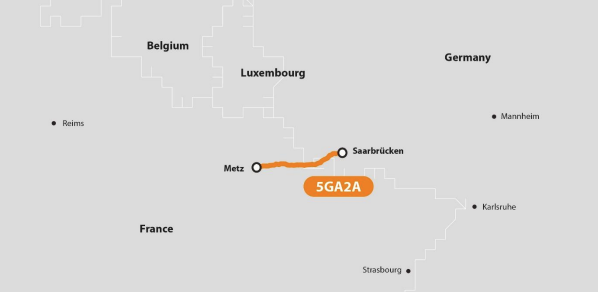
- Corridor: Metz / France to Saarbrücken / Germany
- TEN-T corridor: ATLANTIC Corridor
- Length: 60 km
- Spectrum bands: N28, N7 and N78
- Total EU Grant: €3,981,306.00 (50%)
- Project running
The project will deliver solutions to ensure uninterrupted cross-border connectivity, fostering seamless communication along the corridor. Deploying a robust network, will enable the testing of innovative services and use cases by various stakeholders, stimulating local economies and driving business activities. Additionally, the project will explore new approaches to deploying passive infrastructure along highways, focusing on faster deployment speeds and reduced complexity.
5G ADRIA
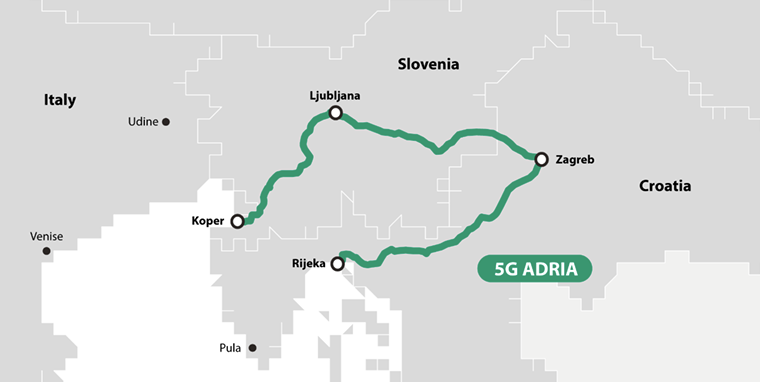
- Corridor: Koper (Slovenia) - Rijeka (Croatia)
- TEN-T corridor: Koper and Rijeka
- Length: 378 km
- Spectrum bands: N28, N7 and N78
- Total EU Grant: €735,225.00
- Project running
The 5G-ADRIA project will focus on defining what 5G infrastructure is needed to support future traffic-related services that will be used along TEN-T transport corridors in Slovenia and Croatia.
5G GIGARAIL

- Corridor: Arnhem (Netherlands) – Emmerich (Germany), part of the Amsterdam-Frankfurt section of the Trans-European Transport Network (TEN-T) North Sea-Rhine-Mediterranean rail corridor
- TEN-T corridor: part of the Amsterdam-Frankfurt section of the Trans-European Transport Network
- Length: 30 km
- Spectrum bands: RMR 1900 MHz, MNO bands 700 MHz and 3.5 GHz
- Total EU Grant: €851,354.00
- Project running: 6 months, December 2024 - June 2025
The 5GiRa study project focuses on the cross-border rail section between Arnhem (Netherlands) and Emmerich (Germany), part of the Amsterdam-Frankfurt section of the Trans-European Transport Network (TEN-T) North Sea-Rhine-Mediterranean rail corridor. This corridor holds significant potential for the deployment of the Future Rail Mobile Communication System (FRMCS) and the Gigabit Train concept, making it a key area of interest for advancing mobile connectivity for rail.
5GE
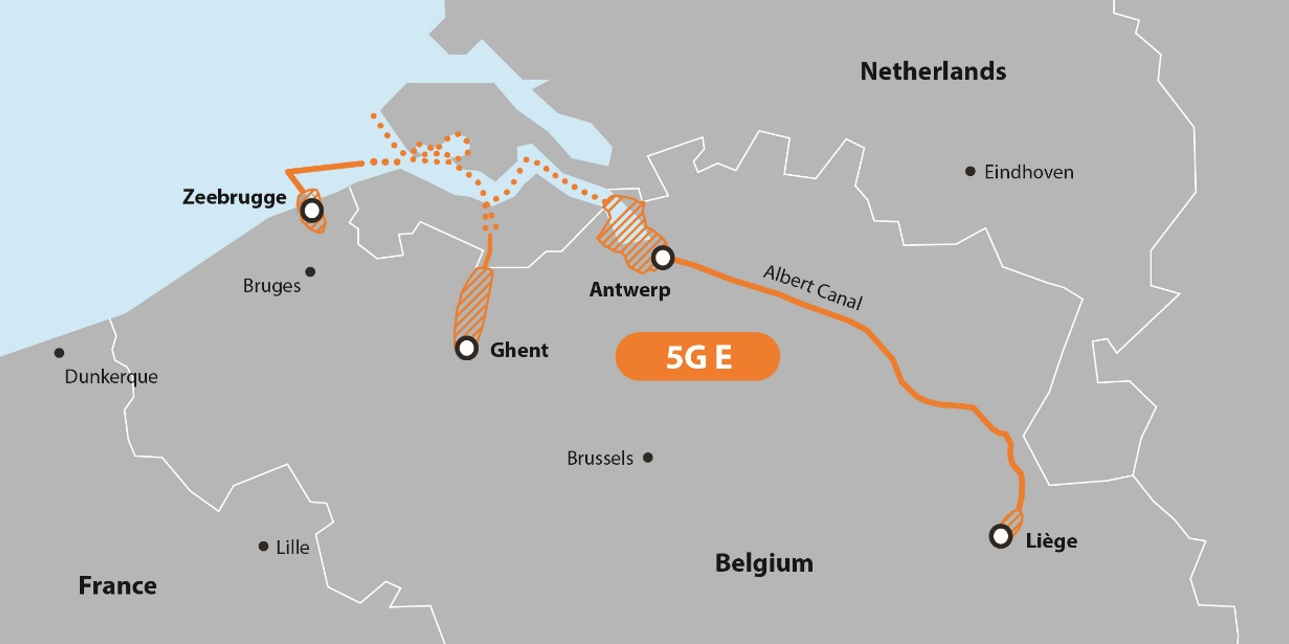
- TEN-T Corridor: North Sea – Baltic Corridor
Corridor: Albert Canal from Liege (BE) to Antwerp (BE), with additional coverage in ports of Antwerp, Ghent, Zeebrugge and at waterway cross-border points between Belgium and the Netherlands in the Scheldt Estuary área. - Length: 157 km
- Spectrum bands: 700, 3500
- Total EU grant:€3,654,116
- Project duration: 36 months (December 2024 – November 2027)
The 5G E project focuses on advancing digital connectivity along the Albert Canal, a critical inland waterway linking Liège and Antwerp in Belgium, and on improving coverage at key cross-border waterway points with the Netherlands. It aims to enable innovative technologies for waterway transport, enhance operational efficiency, and support the transition to smarter, automated, and sustainable shipping solutions.
The GUIDE project is a Coordination Support Action funded by the European Union.
Views and opinions expressed are those of the author(s) only and do not necessarily reflect those of the European Union or HADEA. Neither the European Union nor the granting authority can be held responsible for them.

